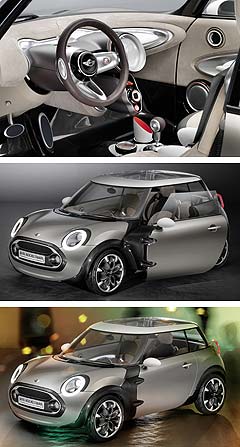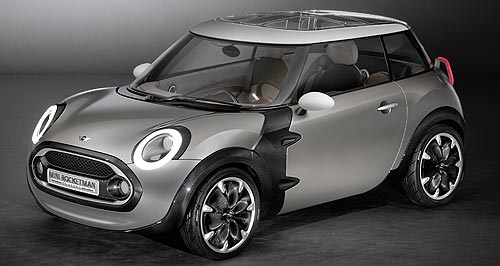Make / Model Search
Future models - Mini - Rocketman conceptGeneva show: Rocketman hints at Mini directionStubby: The Rocketman concept is an original Mini-esque 3.4 metres long but has a thoroughly modern 1.9 metre girth. High-tech take on classic Mini values for ‘Rocketman’ Geneva concept24 Feb 2011 CARBON-FIBRE space frame construction, double-hinged doors and a boot that operates like a drawer are among the wacky highlights of Mini’s latest concept, revealed ahead of its official premiere at Geneva next month. Stranger still is its name, Rocketman, seemingly inspired by a space travel-themed Elton John song from 1972 – especially as Mini claims the concept’s unspecified ‘drive system’ is capable of returning an entirely terrestrial fuel economy figure of 3 litres per 100 kilometres. Unlike recent concepts such as the Paceman, Countryman and even the Moke-inspired Beachcomber – which served as a preview to the Countryman - the Rocketman does not point directly at an upcoming future model. However despite the concept’s apparent wanton eccentricity, the cult BMW-backed British brand is undoubtedly thinking two steps ahead and seeking to gauge public reaction to elements of the design that it is considering for future models – especially as its position is increasingly under threat from competitors like the Audi A1 and Fiat 500. For instance, BMW’s recently-announced ‘i’ brand is to use carbon-fibre construction so it follows that there could eventually be a trickle-down of this technology into future Minis. However Mini is keen to point out that with the Rocketman it is looking deeper into history than cheeky retro looks and reconsidering the use of materials and interior packaging as inspired by the Sir Alec Issigonis-designed original of 1959.  In contrast to the upsizing direction Mini has taken with the recently-launched Countryman, the Rocketman is short at 3.4 metres, although fairly wide at 1.9 metres including mirrors. In contrast to the upsizing direction Mini has taken with the recently-launched Countryman, the Rocketman is short at 3.4 metres, although fairly wide at 1.9 metres including mirrors.For comparison, the original Mini was 3.05 metres in length and 1.4 metres wide while the current Cooper is 3.7 metres long and a slightly narrower than the concept. Despite the extra width and length over the original and the brand’s claims that the Rocketman showcases the innovative use of space, it is clearly biased towards front-seat comfort and misses the mark set by the classic Mini when it comes to room for rear passengers. The concept car is pitched as a 3+1 seater, with one small rear passenger space supplemented by a luggage area that can become a temporary rear seat if the front passenger sacrifices some space by moving their chair forwards. Like the similarly-diminutive Toyota iQ, the Rocketman’s rear passengers would find themselves pressed up against the rear window, with just a few centimetres of trim where the parcel shelf would traditionally be. Mini claims the driver and front passenger are given “just the right amount of space” in two-seater mode with the front seats pushed right back. The instruments move towards the driver “to provide the ideal position for a full-blooded driving experience”. The interior of alcantara, pressed paper and chrome-like finishes also has vast areas of exposed carbon-fibre chassis work and trim strips that would traditionally be made of wood or metal trim are replaced by LED back-lit panels, the colour of which can be customised to suit the mood of the driver. The window sills also light up and the transparent roof that exposes the carbon-fibre roof cross-braces and is engraved with the Union Flag has integrated fibre-optic-illumination. The traditional oversized central speedometer is replaced by a three-dimensional computer display with the speed dial located around its periphery. Rather than a traditional instrument binnacle above the steering wheel, a crystal-like tower displays engine rev and trip computer data. The computer is operated by a trackball on the steering wheel and similarly to BMW’s Vision ConnectedDrive roadster concept, information is prioritised on the display according to its position in the background or foreground. A removable control unit located in the central display can be linked to a home computer pre-journey to set navigation routes, telephone contacts and entertainment playlists. Externally the Rocketman is unmistakeably a Mini. New interpretations of the retro styling theme include a halo-effect low beam setting for the LED headlights and a chrome-surrounded radiator grille incorporating the front spotlights – features that are tipped to make it onto future production Minis. Externally, the concept’s carbon-fibre spaceframe is visible on the wheelarches, lower bumpers, roof pillars, headlight and radiator grille surrounds. The 18-inch alloy wheels also feature carbon-fibre in their design. The outlandish tail light assemblies, which protrude like handles from the Rocketman’s haunches, are a huge step away from the Mini convention and would surely to prove tempting for tired cyclists or rollerbladers to grab for a bit of free propulsion were they to ever make production. Harking back to the 1959 original are the external door hinges, which are contrast-coloured and feature a double-hinge mechanism enabling the doors to be opened forward and out parallel to the body, easing entry and egress when parked in tight spots. The Rocketman’s sills are integrated with the doors to prevent passengers from tripping over them when climbing in and out of the car. The all-transparent upper tailgate comprising the rear window and a triangular section of the rear roof hinges from the centre of the Rocketman’s carbon-fibre roof cross-brace, opening above the rear passenger area so that items to be loaded onto the rear seat/luggage area. Below the tailgate is a drawer, which Mini says is a development of the original Mini’s downward-opening tailgate idea. It slides out 350mm from the behind the rear seat/luggage area for further cargo capacity or to provide space for items when the car is configured to carry four passengers. The drawer can also be locked in the outward position to be used as a ute-style cargo tray for extra carrying ability. It also features inserts for carrying bulky sports equipment such as snowboards. 2267 Minis were sold in Australia last year, up 11.7 per cent although the brand didn’t start 2011 well, with January sales down 23.7 per cent compared with 2010. Local Countryman sales have just kicked off and the two-seat Mini Coupe is expected to arrive by the end of this year, followed by a roadster variant in early 2012.  Read more14th of January 2011  Mini Countryman here next monthRange and pricing announced for Mini’s Countryman crossover20th of December 2010  Detroit show: Mini makes the PacemanStretched three-door Mini Paceman Concept gets the streamlined coupe treatment24th of November 2010  Mini defends market through maturityBMW says it is ready for the influx of rivals set on stealing the baby Brit’s crown27th of September 2010  Mini and Smart show electric scootersGerman giants take to two wheels for the future of urban mobility16th of December 2009  First look: Mini does a MokeBeachcomber concept reprises Moke as Mini gets set to launch baby SUV in 2010All motor show Alfa Romeo Alfa Romeo Abarth Abarth Alpine Alpine Alpina Alpina Audi Audi Aston Martin Aston Martin BMW BMW Bentley Bentley Chery Chery Brabham Brabham Chrysler Chrysler Chevrolet Chevrolet Cupra Cupra Citroen Citroen DS DS Dodge Dodge Fiat Fiat Ferrari Ferrari Foton Foton Ford Ford Great Wall Great Wall FPV FPV Haval Haval GWM GWM Honda Honda Holden Holden Hummer Hummer HSV HSV Infiniti Infiniti Hyundai Hyundai Jaguar Jaguar Isuzu Isuzu Kia Kia Jeep Jeep Land Rover Land Rover Lamborghini Lamborghini Lexus Lexus LDV LDV Mahindra Mahindra Lotus Lotus Mazda Mazda Maserati Maserati Mercedes-AMG Mercedes-AMG McLaren McLaren MG MG Mercedes-Benz Mercedes-Benz Mitsubishi Mitsubishi Mini Mini Opel Opel Nissan Nissan Peugeot Peugeot Pagani Pagani Proton Proton Porsche Porsche Renault Renault Ram Ram Rover Rover Rolls-Royce Rolls-Royce Skoda Skoda Saab Saab SsangYong SsangYong Smart Smart Suzuki Suzuki Subaru Subaru Toyota Toyota Tesla Tesla Volvo VolvoMotor industry news |
Click to shareAll motor show Alfa Romeo Alfa Romeo Abarth Abarth Alpine Alpine Alpina Alpina Audi Audi Aston Martin Aston Martin BMW BMW Bentley Bentley Chery Chery Brabham Brabham Chrysler Chrysler Chevrolet Chevrolet Cupra Cupra Citroen Citroen DS DS Dodge Dodge Fiat Fiat Ferrari Ferrari Foton Foton Ford Ford Great Wall Great Wall FPV FPV Haval Haval GWM GWM Honda Honda Holden Holden Hummer Hummer HSV HSV Infiniti Infiniti Hyundai Hyundai Jaguar Jaguar Isuzu Isuzu Kia Kia Jeep Jeep Land Rover Land Rover Lamborghini Lamborghini Lexus Lexus LDV LDV Mahindra Mahindra Lotus Lotus Mazda Mazda Maserati Maserati Mercedes-AMG Mercedes-AMG McLaren McLaren MG MG Mercedes-Benz Mercedes-Benz Mitsubishi Mitsubishi Mini Mini Opel Opel Nissan Nissan Peugeot Peugeot Pagani Pagani Proton Proton Porsche Porsche Renault Renault Ram Ram Rover Rover Rolls-Royce Rolls-Royce Skoda Skoda Saab Saab SsangYong SsangYong Smart Smart Suzuki Suzuki Subaru Subaru Toyota Toyota Tesla Tesla Volvo VolvoMotor industry news |










Facebook Twitter Instagram